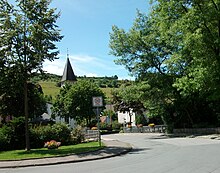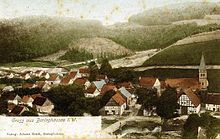Beringhausen (Marsberg)
|
Beringhausen
City of Marsberg
|
|
|---|---|
| Coordinates: 51 ° 24 ′ 31 ″ N , 8 ° 45 ′ 22 ″ E | |
| Height : | 320 m |
| Area : | 5.89 km² |
| Residents : | 916 (2017) |
| Population density : | 156 inhabitants / km² |
| Incorporation : | 1st January 1975 |
| Postal code : | 34431 |
| Area code : | 02991 |
Beringhausen is a district of the city of Marsberg in the Hochsauerlandkreis in North Rhine-Westphalia with around 900 inhabitants, at an altitude of 305 m above sea level. NN .
geography
Beringhausen is located in the narrow valley on both banks of the Hoppecke and at the foot of a number of striking mountain peaks (Enkenberg 495 m, Altenberg 545 m). It belongs to the Diemelsee nature park .
In the east, Beringhausen merges seamlessly with the neighboring town of Bredelar .
The next larger cities are: Diemelsee (8 km) Marsberg (11 km) Willingen (23 km) Brilon (16 km) and Winterberg (45 km).
history
Until the beginning of the 20th century
The oldest, secured documentary mention of the place dates from the year 1101, when Count Erpo von Padberg gave property in "Berdinchusen" to endow the Boke monastery .
Church affairs
The oldest written mention of a parish church and a pastor in Beringhausen comes from October 16, 1230 . The old parish church could be preserved until 1922. The two bells from 1483 were then presumably melted down, as was the cast-iron grave slab of Pastor Orthmann from the 17th century.
A wayside shrine from around 1700 fell victim to a road widening in recent times - an absolute sacrilege according to today's archaeological standards .
In 1883/1884 construction began on the new parish church , which was completed two years later and ceremoniously inaugurated on December 16, 1886.
Thirty Years' War
During the Thirty Years' War , the villages of the Padberg rule, including Beringhausen, were among the worst affected war zones in Westphalia . The reason for this is the proximity to the border with the reformed Waldeck and Hessen-Kassel . Tönies von Padberg noted a total of 40 passages and billeting .
In 1636 Obermarsberg becomes a permanent imperial garrison town. This worsens the war situation in the region. In the same year the Hessians burned down the places Padberg, Beringhausen and Helminghausen . What is left is being devastated and plundered by Croats (Crabats) from the Marsberg garrison . Count Tönies von Padberg notes that the “most miserable state” since the outbreak of war has prevailed in the places he ruled.
In 1638, 28 of the 39 houses in Beringhausen were still in desolation. On top of the misery of the war, an early onset of winter in 1640 led to a weather catastrophe that killed many residents.
Mineral extraction
In 1696 a gold deposit was discovered on the Grottenberg . However, the yield is so low that the "Beringhauser Gold Rush" ended again in 1717.
Up until the 20th century, however, iron ore was mined and smelted in several pits, which was mentioned in a document as early as 1531 (Padberger Eisenhütte).
19th century
Political development
The centuries-long rule of the Electorate of Cologne ended in 1802. Landgrave Ludwig von Hessen Darmstadt appropriated the Electoral Cologne Duchy of Westphalia even before a final settlement was reached.
However, the rule of the Landgraviate of Hesse is only brief. The Sauerland became Prussian as early as 1816 .
At that time, 405 people lived in Beringhausen.
The office of the mayor was abolished in 1824. From then on, the village belonged to the Marsberg mayor's office.
In 1843 Beringhausen received its own local council headed by a mayor . The previous mayorship of Marsberg became the Marsberg office.
In 1975, the communal independence ends and Beringhausen becomes part of the city of Marsberg.
Natural disasters
In 1842 Beringhausen was hit by the greatest fire in its history. 22 houses and 19 outbuildings burn down. This means that half the village is destroyed by conflagration.
The years 1844–1847 were marked by famine , triggered by three consecutive crop failures and the total failure of the potato harvest in 1846.
In November 1890 large parts of the village were flooded by the Hoppecke. The onset of frost destroys the potato supplies in the still damp cellars.
Another year of emergency followed in 1893. An extremely long dry season leads to a bad harvest. The grains are so small that threshing is not worthwhile.
Railroad and electricity
In 1870 the operator acquired the land for the construction of the Upper Ruhr Valley Railway . On June 16, 1872, the first locomotive from Warburg arrived in Beringhausen. She is greeted with gunfire.
In January 1873 the section between Nuttlar and Warburg is officially opened.
In 1907 Beringhausen became a railway stop, and in 1910 Beringhausen station was completed.
On December 6, 1918, Beringhausen was connected to the electricity network.
Second World War
From the beginning of 1945 Allied aircraft appeared over Beringhausen with increasing frequency. From February onwards, low-flying aircraft kept appearing. However, it only appears that two bombs were dropped on the Unterm Steinbrink railway bridge . However, the bombs missed the bridge. The roof of a house was damaged in this attack.
Only now did the construction of air raid tunnels on the valley slopes begin.
On March 29, US troops from Giershagen reached Bredelar. Beringhausen was clogged with fleeing Wehrmacht vehicles, so some of the vehicles were abandoned. In the area around Beringhausen there were several trains in both directions on the tracks of the Upper Ruhr Valley Railway, as the line at Bredelar and Brilon-Wald was interrupted.
On March 31, the US Army occupied Beringhausen without a fight. Seven houses were briefly confiscated. For unexplained reasons, two houses in the village burned down during the first week of occupation. In the following period there were looting and assaults of former prisoners. The residents of Beringhausen also participated in the looting of broken down vehicles and trains as well as depots in the Hoppecketal.
In April the passage of former evacuees and refugees started: up to 150 people walked through the village every day, some with handcarts, bicycles or wagons, as the railway line had been interrupted since March 30, 1945.
In October 1945 there were 1112 locals and 350 evacuees in Beringhausen.
In the Second World War 46 Beringhausers died as soldiers, most of them on the Eastern Front , or died there in captivity and in the hospital.
Incorporation
On January 1, 1975 Beringhausen was incorporated into the new city of Marsberg.
politics
The local mayor is currently Martin Hünemeyer.
coat of arms

|
Blazon : In blue, a resting, winged, golden lion with its head turned backwards, holding a golden abbot's staff in his left hand. Description: The lion is the symbol of St. Mark the Evangelist, to whom the local parish church is dedicated. The abbot refers to the upper courtyard of the former Bredelar monastery, which was located in Beringhausen. Blue and gold are the colors of the von Padberg family, who ruled the town for centuries. The official approval took place on February 20, 1961. |
Culture
Village life is very lively and there are various events throughout the year. It starts in spring with the carnival. Büttensitzung, “Bud Sunday Train” and sausage dinner on Rose Monday are an integral part of the “Great Days”.
In June - usually on Corpus Christi - the SG Hoppecketal football cup tournament takes place.
On the last Sunday in July, the St. Markus Schützenbruderschaft celebrates the traditional shooting festival.
In addition, the parish celebrates the traditional parish festival every two years in September on the church square next to the St. Markus parish church .
The Christmas market and the Christmas concert of the local music association, reinforced by the Giershagen men's choir, take place during Advent.
literature
- Hugo Cramer: The district of Brilon in the Second World War 1939–1945 - reports from many employees from all over the district. Josefs-Druckerei, Bigge 1955.
Individual evidence
- ^ City of Marsberg: Demographic Development 1997–2017. In: City of Marsberg IKEK. Retrieved September 15, 2018 .
- ^ Hugo Cramer: The district of Brilon in the Second World War 1939-1945 . 1955, section Beringhausen, pp. 57-59.
- ^ Hugo Cramer: The district of Brilon in the Second World War 1939-1945 . 1955, honor roll section Beringhausen, p. 218.
- ^ Federal Statistical Office (ed.): Historical municipality directory for the Federal Republic of Germany. Name, border and key number changes in municipalities, counties and administrative districts from May 27, 1970 to December 31, 1982 . W. Kohlhammer, Stuttgart / Mainz 1983, ISBN 3-17-003263-1 , p. 332 .
- ^ Eduard Belke, Alfred Bruns, Helmut Müller: Kommunale Wappen des Herzogtums Westfalen, Arnsberg 1986, p. 134 ISBN 3-87793-017-4



